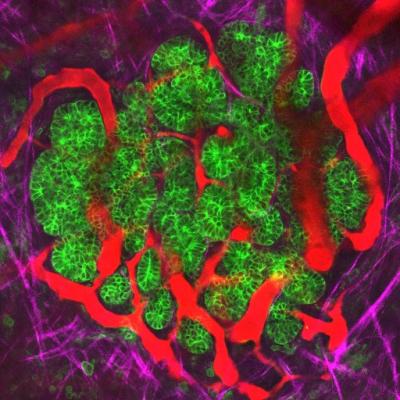A molecule produced by tumour cells, known as perlecan, may be the key for targeting and treating pancreatic cancer.
Pancreatic cancer is an aggressive form of cancer that carries only a 7% survival rate at five years after the initial diagnosis. It is one of the largest causes of cancer-related death. Although there are options available for treating pancreatic cancer, they are only associated with an average survival of less than one year. This, in part, has to do with the absence of obvious signs and symptoms during the early stages of pancreatic cancer. By the time it is diagnosed, cancer has often already spread (or metastasized) to other parts of the body. The poor prognosis and low survival outcomes stress the need for new therapeutic targets for treating pancreatic cancer.
In recent research published in Nature Communications, a team of scientists from Australia, the United States, and the United Kingdom reveal how pancreatic cancer tumours are able to spread throughout the body. To study pancreatic cancer tumours and their environments, the researchers used mouse models and extracted cancer-associated fibroblasts to study how they influence the spread of cancer.
The researchers found that cancer cells, caused by a mutation in the p53 gene, are capable of ‘educating’ the fibroblasts in and around the tumour to produce an environment that supports the cancer cells’ ability to spread. This means that even with only a small number of these aggressive cancer cells being present, it can increase the spread of other less aggressive cancer cells. They also discovered that these aggressive cancer cells are capable of manipulating and remodeling the surrounding tissue to protect themselves from chemotherapy. One of the ways these cancer cells do this is by producing a molecule known as perlecan. The scientists then studied pancreatic cancer mouse models where they lowered the levels of perlecan. They discovered that this not only reduced the spread of cancer but also improved the tumour’s response to chemotherapy treatment.
These findings provide key insight into potential new therapeutic targets for treating pancreatic cancer. Traditionally, cancer therapies have focused on targeting the cancer cells, but little research has been done on targeting the surrounding environment of the cancer. Targeting perlecan, and other similar molecules found in the tumour’s surrounding environment may be effective in treating pancreatic cancer as well as other types of cancer, such as prostate or breast cancer.
Written by Maggie Leung, PharmD
References:
Vennin, C., Mélénec, P., Rouet, R., Nobis, M., Cazet, A. S., Murphy, K. J., . . . Timpson, P. (2019). CAF hierarchy driven by pancreatic cancer cell p53-status creates a pro-metastatic and chemoresistant environment via perlecan. Nature Communications,10(1). doi:10.1038/s41467-019-10968-6
Key to targeting the spread of pancreatic cancer. (2019, August 12). Retrieved from https://www.eurekalert.org/pub_releases/2019-08/giom-ktt080719.php
Image credit: Max Nobis



